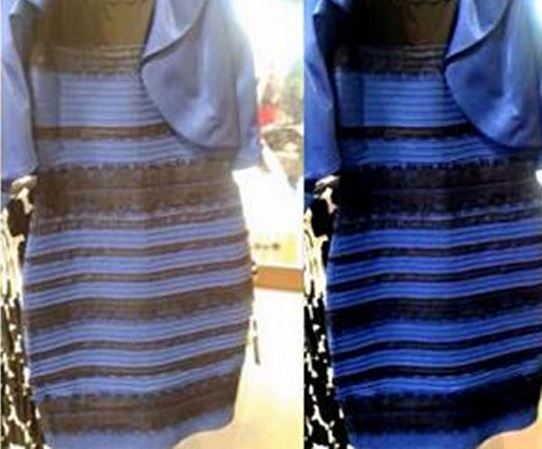Why did some people see a blue and black dress while others saw it as white and gold? It was all down to the photograph’s overall yellowish and bluish colouring, says a team of perceptual psychologists from the University of Giessen in Germany and the University of Bradford in England.
Prof. Dr. Karl Gegenfurtner, who works at the department of psychology at Justus Liebig University Giessen, said “This would not have happened with a red dress.”
In this latest study, the researchers reported their findings in the academic journal Current Biology (citation below).
Is this dress blue-black or white-gold?
The team, which included Professor Marina Bloj from the University of Bradford, found out that all the test subjects basically perceived similar colour shades, which only varied in lightness.
The perception of colours ranged from a very light, nearly-white blue, to bright mid-blue, from yellow and gold to an intense and dark brown which was nearly black.
And yet, however, the transitions are fluid: Neither those who viewed the dress as white and gold nor individuals who perceived it as black and blue constitute a homogenous group.
Daylight colours change during the day
The perceived colours, however, have something in common. They all form part of the so-called ‘daylight locus’. Depending on where the sun is positioned during the day, daylight tends to be more bluish at noon, and slanting more towards yellowish in the morning and evening.
Most of us are able to unconsciously filter the effect of yellowish or bluish light, with the result that we all perceive the same colours.
In order to do this we require reference points, thus colours, which are located outside the daylight locus. However, in the case of #TheDress (as it was called in social networks), the green and red features were completely missing.
Therefore, the image did not provide relevant information on the scene’s luminance levels.
Prof. Gegenfurtner explained:
”The perceived hue in one of the groups of observers is related to the fact that a white dress was exposed to cool bluish light. Just as well it could be a blue dress which was overexposed by warm light.”
Now we all know that the dress was, in fact, blue-black in colour, a matter the researchers describe as of ‘minor’ importance. The observers do not consciously decide one version or the other.
Several studies have shown that humans find it hard to perceive colours along the daylight locus accurately.
Test volunteers are, for example, seldom able to see a completely neutral grey on the screen without tending to a slightly yellowish or bluish tinge.
The researchers wrote:
“Deviations concerning red or green tendencies on the contrary hardly ever occur, which, in turn, explains why a red and green colouring of the dress on a screen by the team of authors has not led to any perceptual disagreements among the test subjects.”
In an Abstract in the journal, the authors concluded:
” We speculate that the ambiguity arises in the case of this particular image because the distribution of colours within the dress closely matches the distribution of natural daylights. This makes it more difficult to disambiguate illumination changes from those in reflectance.”
Citation: “The many colours of ‘the dress’,” Karl R. Gegenfurtner, Marina Bloj and Matteo Toscani. Current Biology. Published May 2015. DOI: 10.1016/j.cub.2015.04.043.

